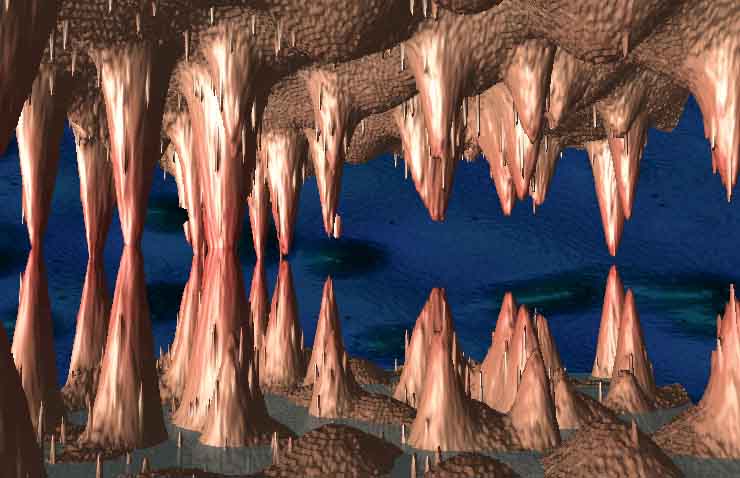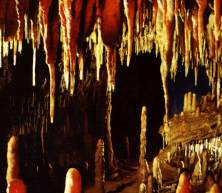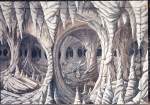
The image below depicts one virtual universe in which we may wish to spend our afterlives. This is a virtual cave that I actually evolved by modeling the dripping process from a synthetic cave ceiling. Surprises are everywhere. Results are unpredictable.

Let me tell you where I have been spending my weekends. Although I am in my office listening to Andreas Vollenweider's "Caverna Magica" on my headphones, thirty miles of caverns plunge and twist away from me in every direction. There are passages of impenetrable stalagmites.
I shine a light into a crevice. The surfaces of the cave walls are aquamarine. Above are glittering stalactite chandeliers. I imagine the air smells clean and wet, like hair after it is freshly shampooed.
I walk a little further. Huddled together like little hobbits, the smaller stalagmites of calcite cluster near a clear pool. The larger ones look like rib bones of some giant prehistoric creature.
With just a few clicks of the mouse, I've entered another world, a virtual world created with mathematical simulations and computer graphics.
Ever since I've read about the Lechuguilla Cave deep beneath a southern New Mexico desert, I've become fixated on cavern synthesis -- getting my computer to create a lifelike giant maze whose furthest chambers are as yet unfathomed. I created the image above as a snapshot of one region of my virtual cavern.

 With your help, I hope to create caves like this that extend for miles, and then
we can explore the cave together, searching for interesting geological
formations and treasures.
I'd like to see caverns that you simulate on your own.
The precise recipe is given in my book
Wonders of Numbers.
The process is very simple and models dripping from the ceilings of caves.
With your help, I hope to create caves like this that extend for miles, and then
we can explore the cave together, searching for interesting geological
formations and treasures.
I'd like to see caverns that you simulate on your own.
The precise recipe is given in my book
Wonders of Numbers.
The process is very simple and models dripping from the ceilings of caves.
If you want to see some real caverns, take a look here.
 <--- Click on the
Charles Hughes cave image at left
to magnify.
<--- Click on the
Charles Hughes cave image at left
to magnify.